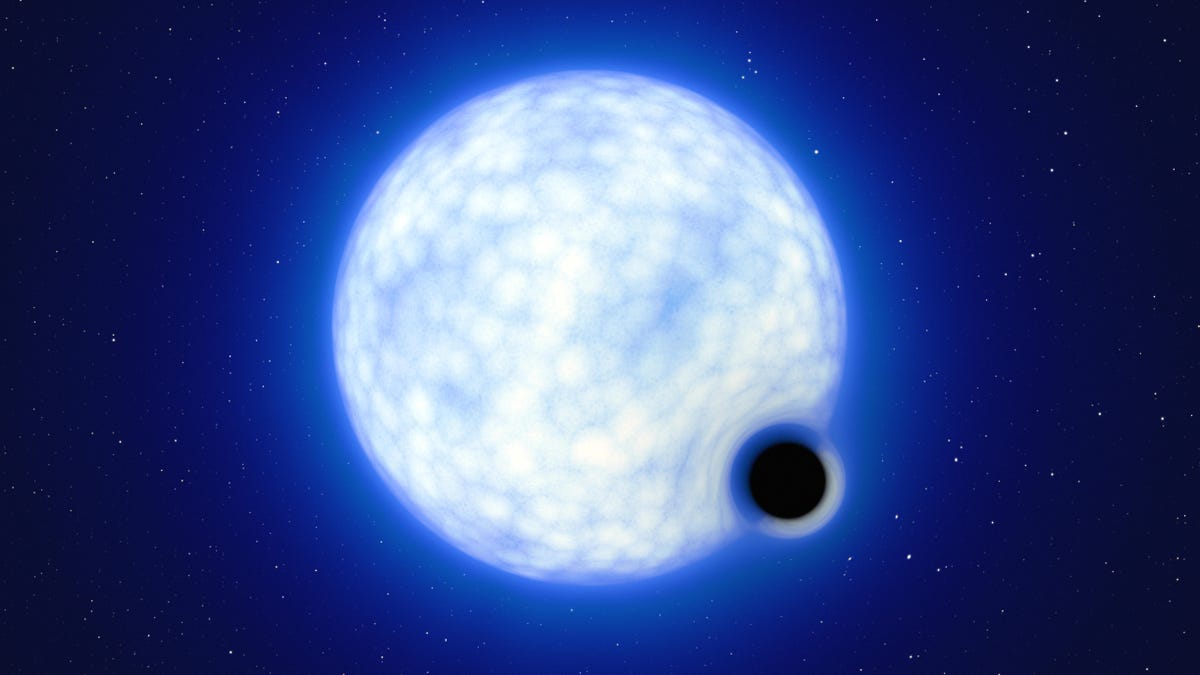'Black Hole Destroyers' Just Found a Strange Black Hole Lurking in Deep Space
It's the first time a "dormant" black hole has been unambiguously detected outside the Milky Way, the researchers say.

An artist's impression of VFTS 243, a binary system containing a super-hot star and, potentially, a dormant black hole
Tomar Shenar calls his colleague, Kareem El-Badry, the "black hole destroyer."
El-Badry, an astronomer as the Center for Astrophysics, a collaboration between Harvard and the Smithsonian, has been skeptical of black hole discoveries in the past. When astronomers suggested they'd found a monster black hole so big it "should not exist," El-Badry helped show that it, well... probably doesn't.
But Shenar, an astrophysicist at Amsterdam University in the Netherlands, is something of a black hole destroyer himself. In March this year, he was part of a team that showed the closest black hole to Earth is likely not a black hole at all. All of this so-called destruction is great for journalists and headlines, of course, but in reality it's just good science — as astronomers gather more data on stars, black holes and binary systems, they refine their understanding of the cosmos.
Today, the pair have teamed up (with many other collaborators) not to wipe a black hole from existence, but to discover a new one. It's pretty rare, and a little unusual.
In a new study, published in Nature Astronomy on July 18, the researchers examine a binary system known as VFTS 243, around 160,000 light-years away. Pointing the European Southern Observatory's Very Large Telescope at the Tarantula Nebula for six years, the team was on the hunt for humongous stars that might have a black hole companion. With VFTS 243, they found what they were looking for: a big star — belonging to a group known as the "O stars" — and... something else.
"What we 'see' in the data is a very massive star (25 solar masses) orbiting periodically around something we do not see," explained Shenar via email.
Shenar noted that the unknown stellar companion has a mass about nine times greater than our sun. The challenge was then to prove this unknown cosmic object could not be anything but a black hole.
This animation shows how the two cosmic objects of VFTS 243 orbit each other. This is not to scale -- data suggests the star is about 200,000 times larger than the black hole.
There was a list of possibilities for the companion object, according to Shenar. It might have been another normal star, about six times as massive as our sun. Or perhaps it was a helium star that has been stripped of its outer layers because of interactions with another star. And then there's a more exotic idea: It could be that the extra object is actually two smaller stars that are themselves orbiting each other in a binary.
Shenar took the data to El-Badry, who noted that the team "could not find a plausible explanation for the data that did not involve a black hole." For someone hailed as a "black hole debunker," that seems like a fairly significant claim. He added that there are no alternatives in our current knowledge.
"Either it's a far invisible alien, or a black hole," he said.
What makes this pairing of O star and black hole particularly interesting is that the researchers can deduce what happened before the black hole was born. If we'd looked at VFTS 243 in the distant past, we would have seen two massive stars dancing around each other.
Eventually, one of these stars runs out of fuel and collapses. Typically, astronomers believe, this collapse would result in a huge explosion, known as a supernova -- and a black hole would be left behind. But the black hole in VFTS 243 appears to have collapsed without exploding at all. A curiosity, but not without precedent.
"In the last 10 years or so, theoretical models have started predicting that there should be 'regions of mass' where black-hole progenitors do not explode," Shenar said. The almost circular orbit of the pairing, he said, arguably provides the first direct evidence for a black hole created without an explosion.
Another curiosity? Astronomers have been able to find these types of black holes by looking at X-ray radiation in the past, but the black hole in VFTS 243 is X-ray quiet and not very active. The team calls it a "dormant" black hole and contends that it's the first to be unambiguously discovered outside of our home galaxy.
Both these curiosities are important in understanding binary black hole systems and how they form. Astronomers have been fascinated by these pairings because they throw off gravitational waves as they spiral toward each other — but how they come to be is still a puzzle. Since the gravitational wave detectors in the US, Italy and Japan came online, almost 100 black hole mergers have been detected. VFTS 243 might be giving us a view into the type of system that gives rise to these black hole doubles, making it "a very important component in theoretical models," according to Shenar.
We've been talking about all this creation, but now let's get back to the destruction.
The team predicted the fate of the pairing, sometime in the distant future, and spoilers: They're doomed. The gigantic star will eventually collapse and form its own black hole, which means the binary will become a black hole-black hole duo in about 5 million years. This will throw out gravitational waves as the pair circle each other for close to eternity, until eventually, they will collide. That's predicted to occur in a few hundred billion years.
By that time, though, I suspect every atom that makes up this article, you, me, the birds and the bees... all of those atoms will be long gone.

